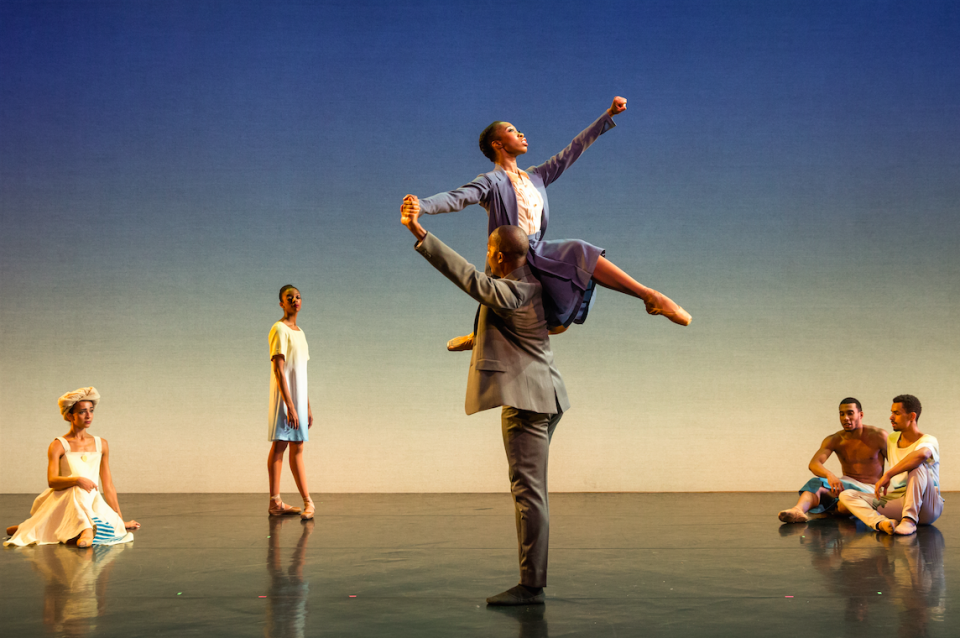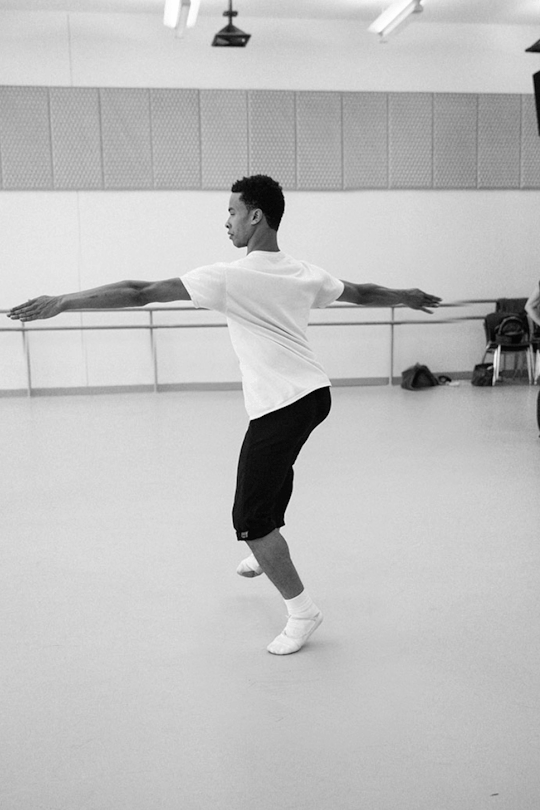What Happens When Ballet Puts Black Lives at Its Center

Photo: Getty Images
This past year, “the black body” has become a refrain for a certain type of urban intellectual. The term originated with scholars-a way to describe a trope that appears again and again in the images we create and see. Whenever I read the phrase, I always heard it in the low, angry howls of Billie Holiday and Nina Simone, singing that putrid line in “Strange Fruit.” But as this year of death and surveillance marched on, I began to hear and see others using it. People debated on social media about whether they should post images of police shootings. They decried the New York Daily News, which chose to print a graphic picture of Alton Sterling’s body the day after he was murdered. “I can’t see any more mutilated black bodies” they said. And I thought, They are right.
“To have a black body in America almost always means that you have a problem.”
To have a black body in America almost always means that you have a problem. Your body is, according to the dominant narratives, not right. You are subhuman and superhuman all at once. Capable of extraordinary athletic feats, of breaking records without breaking a sweat. While also capable, we are told over and over again, of growing too big, too fat, too sick, too diseased.
Most black women of my age, if they took ballet as little girls, have a story of being told they were too much. “Tuck your backside in,” was the admonishment in my dance class when I was young, a command I couldn’t understand. Wasn’t it clear it was tucked as far as it could go? “They always tell the black girls to do that. They just don’t understand our behinds,” my sisters said with a laugh, and the momentary shame I felt about not being able to tuck in, was dispelled by my sisters’ dismissal of the whole concept. Tucking in, I thought confidently, is impossible. And I promptly gave up ballet with no regrets.

It’s a revelation, then, to watch the dancers of the newly-formed Black Iris Project, which bills itself as a “ballet collaborative that champions new Black-centric works and arts education.” Here, the black body is not in pain; it is not a problem to be solved. It is celebrated. In Madiba, one of the collaborative’s signature ballets, the life of Nelson Mandela is elegantly dramatized in 22 minutes. At a preview performance at the Schomburg Library for Research in Black Culture in Harlem, I watch two young dancers, a man and a woman, perform the love story of Nelson and Winnie Mandela. The man lifts the woman, curves himself to her back, arcs one hand out to her, longingly, with pleasure. I know something is different as I watch, but I can’t put my finger on what it is-why this dance feels so revolutionary-outside, of course, how beautiful it is.

After the preview, Black Iris Project’s founder and choreographer Jeremy McQueen, Madiba dancers Daphne M. Lee and Lawrence Rines, and the ballet’s composer, Carman Moore, take the stage to answer questions from the audience. Lee points out that, as a black dancer, “often, we’re the only one, or one of the only ones, in our company. They don’t cast us to dance together. You don’t see a black couple dancing together in a predominantly white company.”

I think about that, about the anomaly of tenderness, about the revolutionary nature of choreographing new ways to love.
Toward the end of the talk, an older woman stands up in the audience. “I’d like to ask the young sister,” she says, meaning Lee, “Why don’t you wear your hair natural? Let it be free. Dance with an afro in the ballet. You’re a role model for our young.”
Lee sits up straight in her chair. She chooses her words carefully. “This is about the history of the dance,” she says. The dancer’s bun, she explains, is a tradition of classical ballet; historically, it’s a way to symbolize to the audience that the dancers were professionals, artists. “I want to show our hair can do this as well,” she says. “I want to show that we can be a part of this.” This statement makes me want to Google “black hair in dancer’s bun” and search for this possibility. But I also realize it’s the paradox of tradition: You are drawn in by the rituals, by the sense of belonging, but you are reminded of the ways you don’t quite belong.
For Black Iris Project founder Jeremy McQueen, this paradox simply doesn’t exist. He’s willed this alternate vision of black bodies and beauty into existence, certain of the artistic vision he wishes to see. He founded the collaborative this year as a way to showcase black ballet professionals (he uses the term collaborative rather than company as the dancers in Black Iris all dance in other professional companies throughout the U.S.) and create classical ballets rooted in black history and the black experience. The three ballets of the inaugural season-Madiba, Black Iris, and Brown Baby-were conceived by an artistic team made up entirely of artists of color. In addition to the majority of the dancers in the collaborative, the choreographers, costume designers, composers, and lighting designer are all people of color.

“I felt like many of my students weren’t particularly interested in ballet because of the lack of visibility.”
McQueen is a gifted choreographer-in 2013, he won the Joffrey Ballet of Chicago’s Choreographers of Color Award. He’s presented choreographic works at Jacob’s Pillow, has performed in the national tours of Wicked and The Color Purple, and has taught ballet for both American Ballet Theatre (ABT) and Alvin Ailey’s outreach programs. It was through teaching that the need for Black Iris Project became clear. “A great number of my students were minorities,” McQueen says in a video about the making of Madiba. “For minorities there’s this real sense that once you see someone on stage that looks like you, it really provides an extra boost of inspiration and encouragement. I felt like many of my students weren’t particularly interested in ballet because of the lack of visibility.” Because representation matters. And so does access.
McQueen was introduced to dance by his parents, who took him to performances at a very young age. “My parents went to a historically black college, and they were first introduced to the arts there,” he says when we meet a few days later in the lobby of the Marriott in Times Square, which is around the corner from the New 42nd Street Studios where the collective is rehearsing for a two night engagement with New York Live Arts. “They grew up in very large families and were very poor, so their families couldn’t afford to take them to go see Broadway shows. They made an effort to go out and explore the things they heard about themselves.” His parents’ lives and spirits are infused in the ballets he’s created.
In 2013, McQueen was commissioned to create a ballet for the Joffrey Academy of Dance in Chicago. That ballet became Black Iris. The mood of the piece was inspired by a Georgia O'Keeffe painting McQueen saw at the Metropolitan Museum of Art. He encountered the painting shortly after his mother was diagnosed with breast cancer. “Visually, nothing had really struck me before,” he says. “It reminded me of my mother…she has had to overcome so many different challenges-from her own battle with cancer as well as supporting my father’s battle through cancer. And even segregation. She lived through that in the South, and the assassination of Dr. King. And she has continued to press forward and continued to inspire others. And so I wanted to create a ballet that encompassed what I feel personifies my mother and many other women, specifically black women, and the strides that they have taken.”
In addition to Black Iris, the two other ballets McQueen created for his troupe’s inaugural season are Madiba, and Brown Baby, about the daughter of a black American WWII soldier and the German dancer he meets after the war. (The latter was co-choreographed with Lauren Cox, whose grandmother served as inspiration for the story.)
McQueen’s co-collaborators are keenly aware of the uniqueness of these particular productions. Says dancer Christina Spigner, “Everything is so deliberate. There are so many conscious choices. Everything is so meaningful. Like, this was choreographed for this specific work, and this specific character to tell this specific story, and that doesn’t really happen a lot.”

Black Iris Project is only a few months old. Its future depends on cultivating an audience of ballet and dance fans. And this comes back to access. McQueen dreams of touring historically black colleges. “What kind of impact could we have if we take it directly there?” he says. “In order for the arts to survive, we need supporters, and in order for us to see the change and the diversity in the types of ballets that are being created, and the types of operas that are being presented, we have to show and express that there’s an interest for that.”
At the end of the Schomburg presentation, McQueen reiterated how much of the Black Iris Project is a labor of love. They’ve received some matching grants to help fund their production, but they still need to crowdsource $50,000.00 to make their projected budget. “Please tell your friends and family,” he said, and then the talk was over.
As I waited for my turn to congratulate McQueen, it became clear to me that, more than anything, the audience was vying for connection. An older woman gently pushed her way to the front of the line, pulled a folded up bill from her pocket and slipped it into McQueen’s hand before turning to walk away. She didn’t speak to him during the whole exchange. And then the line surged forward. People reached out to touch McQueen, touch the dancers, take pictures with them. One woman stood at the edge of the stage and asked McQueen for suggestions of where she could send her granddaughter for dance class. He patiently answered, but the woman was insistent. “What if she doesn’t like that one? Can you help?”
As I stood in line, waiting for my turn to congratulate Jeremy, I listened to the people around me. Some used their own stories about their love of dance, others simply wanted to tell him about their most talented relative. Some quoted scholars and activists and historians.
And I was there with them, not exactly sure how to express my reaction to what we had just seen. Worried that if we didn’t find the words, we may never get to see it again. Worried that words could never do the feeling justice.

